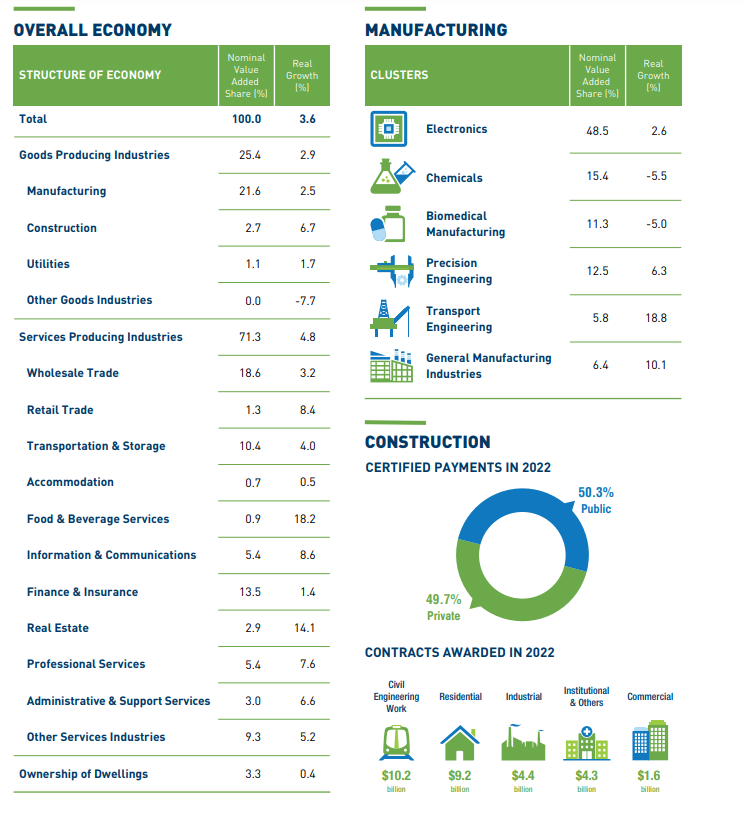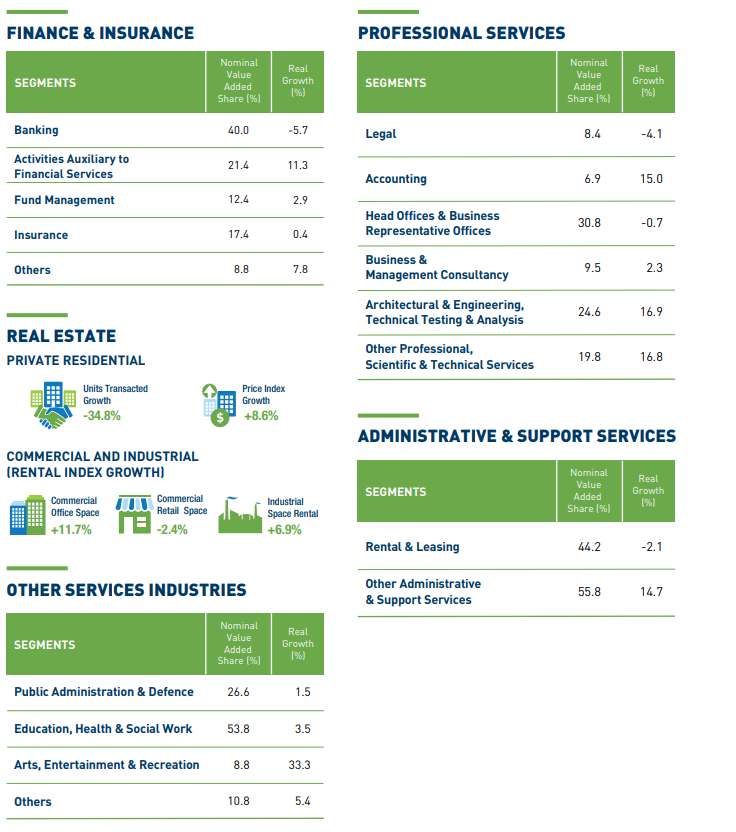share on
GDP growth forecast for 2023 is maintained at "0.5 to 2.5%", keeping in mind factors such as the expected pick-up of growth in China, tighter financial conditions across many advanced economies, and more.
Singapore saw its economy expand by 3.6% in 2022, moderating from the 8.9% growth recorded in 2021. Additionally, according to the Ministry of Trade and Industry (MTI)'s Economic Survey of Singapore 2022, released today (13 February 2022), all sectors recorded full-year expansions, with the wholesale trade, manufacturing, and other services sectors.
Looking at the performance in the final quarter of 2022, the economy recorded a 2.1% year-on-year growth in Q4, moderating from the 4% expansion recorded in the previous quarter. On a quarter-on-quarter seasonally-adjusted basis, the country's GDP grew marginally by 0.1%, slower than the 0.8% growth in the third quarter.
Taking into account various factors cited in the report – such as the expected growth pick-up in China following its easing of COVID-19 restrictions; tighter financial conditions across many advanced economies that have been raising interest rates, and more, MTI has maintained the GDP growth forecast for 2023 at "0.5 to 2.5%".
Growth by sector/industry in 2022
In contributing to Singapore's overall economic performance for the year, the manufacturing sector saw 2.5% growth in 2022, slower than the 13.3% growth it observed in 2021. Within the sector, all clusters recorded expansions, except for the chemicals and biomedical manufacturing clusters, it was added,
Meanwhile, the construction sector saw a growth of 6.7% in 2022, extending the 20.5% expansion recorded the year before. This, MTI reported, was supported by both public and private sector construction works.
Finally, an expansion of 4.8% was recorded in the services producing industries in 2022, easing from the 7.6% expansion recorded in 2021. Here, growth was mainly driven by the wholesale trade, other services, and information & communications sectors.
Full overview below:



Singapore's labour market in 2022
Among the many factors covered, the report looked at how Singapore's labour market and productivity fared in 2022.
On the employment front, total employment in Singapore surged by 254,000 in 2022, picking up from the increase of 40,200 recorded in 2021. Excluding migrant domestic workers, total employment grew by 231,700.
By quarter, the total increase recorded in employment was recorded at 52,000 in Q4, a "moderate pace of increase" when compared to Q3 (+83,400) and Q2 (+71,000).
Next, breaking the numbers down by broad sectors, total employment expanded across all, with the services sector registering the largest gains (+128,000), followed by the construction (+91,400) and manufacturing (+34,000) sectors.
In growth terms, a rise in employment was noted in services (+35,500), construction (+14,000), and manufacturing (+2,300) in Q4. Within the services sector, specifically, both the other services and F&B sectors recorded the largest gains in employment (+12,400 and + 7,900 respectively).
On the unemployment front, between September and December 2022, the seasonally adjusted unemployment rate eased at the overall level (from 2.1% to 2%), and for residents (from 2.9% to 2.8%) and citizens (from 3.1% to 3%).
In December 2022, there were 67,400 unemployed residents, of whom 59,800 were Singapore citizens. These figures were lower than the number of unemployed residents (70,800) and citizens (62,400) in September 2022, the report added.
For 2022 as a whole, the annual average unemployment rate declined at the overall level (from 2.7% in 2021 to 2.1%), as well as for residents (from 3.5% to 2.9%) and citizens (from 3.7% to 3%).
On average, the number of residents who were unemployed in the year stood lower than that recorded in 2021: in particular, an average of 69,600 residents (comprising 62,000 Singapore citizens) were unemployed last year, fewer than the 84,300 unemployed residents (comprising 75,700 Singapore citizens) seen in 2021.
Last, coming to retrenchments - according to the report, the number of retrenchment recorded in Singapore in Q4 2022 stood at 3,000, up from 1,300 recorded in Q3. Notwithstanding this increase, the number of retrenchments in the fourth quarter remained within the range of quarterly retrenchments observed in 2019. Over the quarter, retrenchments rose in the services (from 1,050 to 2,000), manufacturing (from 250 to 900), and construction (from 10 to 100) sectors.
However, MTI noted that while retrenchments did increase in Q4 2022, the total number of retrenchments for 2022 as a whole (6,450) was lower than the level recorded in 2021 (8,020). The trends were mixed across the broad sectors. Specifically, retrenchments fell in the services (from 6,020 to 4,360) and construction (from 240 to 180) sectors, but rose in the manufacturing sector (from 1,710 to 1,910).
Income growth in 2022
Keeping the above in mind, it was shared that reflecting the recovery of the labour market in 2022, both nominal and real gross monthly income of resident workers increased in the year. Specifically, the nominal median gross monthly income (including employer CPF contributions) of full-time employed residents grew by 8.3% to reach S$5,070 in 2022, extending the growth of 3.2% in 2021.
After adjusting for inflation, real median income increased by 2% in 2022. Lower-income earners also saw growth in their incomes after taking inflation into account, with real income at the 20th percentile rising by 4.7% in 2022.
Further, over the last five years (i.e., June 2017 to June 2022), real median income rose by 9.4% cumulatively, or 1.8% per annum. During this period, real income growth at the 20th percentile exhibited stronger growth (15.4% cumulatively, or 2.9% per annum), thus narrowing the income gap with the median income earner.
Lead image / Shutterstock
Follow us on Telegram and on Instagram @humanresourcesonline for all the latest HR and manpower news from around the region!
share on
Follow us on Telegram and on Instagram @humanresourcesonline for all the latest HR and manpower news from around the region!
Related topics


